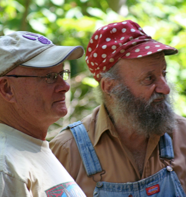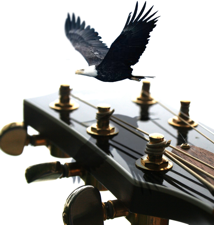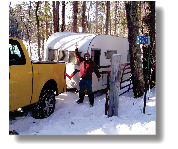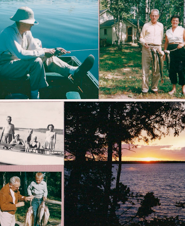Perhaps more than a few summer people (Bea Eggar used to say, “Some are; some aren’t.”) have childhood memories of Sand Lake. One is John Perkins who first visited Sand Lake in 1952 and today calls Sand Lake home.
What’s kept him coming back to his family’s property on the south shore? The answer is the subject of most of the songs he writes and performs. In fact, the lyrics celebrate many of the reasons most residents find are their own. His audiences know first hand what John sings about.
Whether it’s singing to the trees and the lake from his back porch, on stage at The Edge of the Wilderness Art Center, or at our Community Center... his songs celebrate a life-long narrative that actually began before he was even born. The following is the story behind the songs … “the rest of the story.”
In the 1920s, two brothers John and Will Van Deursen bought 80 acres on Sand Lake including lakefront from the western part of the long sand beach at the southeast end of the lake, around the “point”, and down the western side of the “boot” or “channel.”
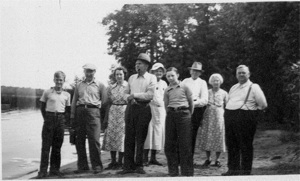
At the time, the roads to the parcel were primitive. The passable road ended where Lakewood and Peaceful Valley resorts are now. Rainbow Road and Mini-Car-Car Lake Road were logging trails. To solve the problem of getting to the property, Harms bought a small, additional piece of property in Lakewood Bay next to where Lloyd Westermann lives. This little wedge had 50 feet of lake frontage on which he put a boathouse. He’d drive up from Chicago, park his car at the end of the road, get in his boat and motor out to the “point.” Longtime resident and friend, Ludwig Hataja, trenched an access from the lake into a boathouse built on the channel just south of the “point.” Harms simply motored his big old wooden boat into the boathouse, and walked up the bluff to his tarpaper sided cabin. Perkins has his dock in the same spot today. This was the property’s access for years until Harms turned a “deer path” into a drivable road and eventually in the 1950s had the power company bring electricity to the cabin.
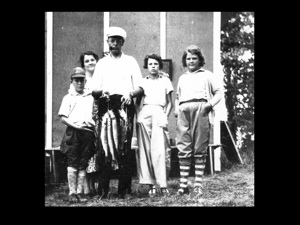
Then along came John Perkins. He was born in 1946. It was his maternal grandparents who were coming up to his uncle’s cabin. His grandfather’s sister had married John Harms. The Rieger family with young John Perkins stayed at Sand Lake Lodge during their visits. The cabin was too small to accommodate them. They’d stay two weeks starting in 1952.
John loved the lake and the woods; and he liked that old primitive cabin, and the long, windy road that seemed “to go on forever.” To this day, he recognizes the trees along the road his grandfather pointed out to him. He absorbed all this, and his music is imbued with the spirit of boyhood wonderment.
When he was in college, John came up here with college friends. When he got married, he came up for a “magical honeymoon.” He has a son, and they’d come up here, and camp and fish 12 hours a day. His son would bring his toys and play with them in the front of the boat. The 12 years John missed coming up to Sand Lake he went to the BWCA. After his divorce, he started coming up here again with Sandy, to whom he is now happily married.
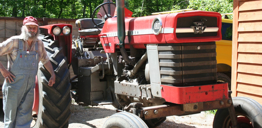
After 46 years of vacationing at Sand Lake, John was ready to LIVE at the Lake. At first John lived in a trailer, but he got a building permit in 1998. He built a garage and lived in it before he built his house. John loves to sit outside and play for the trees and Darby, his dog and any fishermen who happen to be there on the lake in front of his cabin.
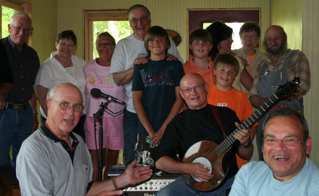
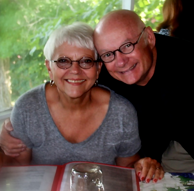
He was at the cabin after his divorce from his first wife, and it had been an emotional time. Just being there became an epiphany – he told himself, “you can be fixed.”
Many performers are moody. John has written many of his songs during his happy times, but some beautiful songs have come from the sad times. They’re not happy but poignant, very real. They come from a very deep place inside him. He asks Sandy, “Should I really do these?” She says, “You should do them – in certain places, not everywhere – certainly not at Bud and Gin Kitterman’s 60th Anniversary.” He says these songs are part of him. He points out that John Denver wrote songs like this too. Music should express a person’s whole life, his entire self.
John has lived in populated suburbs with “worrisomely few friends.” He has counted on Sandy to be the sociable one but was often here by himself. A happy part of John’s life is the community he has found up here. He said he has more friends up here than he’s had in his entire life. John has wacky friends and friends who are regular Lake Woebegone Lutherans. Some are even Republicans. They have their own views but still get along. They don’t argue with each other about divisive, touchy issues.
At the time of the interview, John was working on a song: “I’ve got to find new dreams, I’ve got to find new things to do, come with me. Come on with me, baby, I’ve got places to go.” He’s talking about “going out the window, down the wall, … there’s new dreams to [find] out there.” He wants to build an acoustic music venue here in the woods and continue his music. He’s written a children’s book, and has a greeting card company ready to start called “Sticks and Stones.” It’s the sticks and stones he finds in his woods. He wants to take black and white photographs of them and write captions.
Willy Frederick is one of John’s friends. He’s a former air traffic controller, a maple syrup man, who hunts and fishes. Willy’s taken John under his wing, introduced him around, and opened up more friendships for John.
Another friend, Charlie Ramos, was a jeweler for 20 years in Deer River, was an Army brat, is a Latino, left wing, a friend of the liberal community in Grand Rapids. Charlie’s daughter’s a wardrobe artist for a rock band. (Charlie has since moved to Florida.)
Believe it or not... Willy and Charlie always got along.
Great Uncle John’s friend Ludwig’s son Richard asked Perkins for permission to hunt on his property. John said, “Sure... as long as I get some venison.” The Hataja family is part of the original Sand Lake community who helped build homes and resorts around the lake. Hataja’s are, John said, an important thread that runs through the fabric of our community.”
These connecting threads aren’t as apparent in a big city. Here relationships happen with ease for John. When he needs help with something, he knows someone who can help him. He says we take care of each other.
John’s a member of the property owners association (SLPOA). Because of his graphic arts background, he does their newsletter. He’s also designed a website to promote his music. When he volunteered to deliver the fishing regulation cards for the association, he got to meet all the resort owners on Sand Lake.
John believes there are places in the universe where something is missing and “you get plugged in.”
He does admit it would be difficult for him to have finished out his advertising career and finally retired here if there hadn’t been internet access to the property. Now, glory be, fiber optic cable comes right to his house. He says it’s “unbelievable” that there is fiber optic here in the wilderness. (At this writing it’s one of the few, if not the only, rural communities to have fiber optic.)
It’s also important to John that he’s a steward of his land. It’s part of the Chippewa National Forest and the Leech Lake Reservation. He has experienced this area from a young boy through to adulthood, as the property has been passed on to him from his extended family. His song “Spirits In The Wind” captures some of the magic of all those who have walked the woods on the west bank of the channel.
He’s found his niche in these parts with his music. Marcie Lindgren is his contact at The Edge of the Wilderness where he has performed. He’s sung in the talent search at the Reif Center and for audiences at his home and at all kinds of community groups and events. With his wife playing spoons, he even played at the “Jug Band Boogie” contest held every year at Deer Lake Charlies east of Effie.
He played for the June, 2011, potluck and meeting of the Evergreen Friendship Club. The songs he sang, accompanied by Jerry Hagen, a friend of Marcie Lindgren, are about the place we all love. One couldn’t say anything about his voice, his guitar playing, and certainly the lyrics to his songs without understating them. We wonder why he doesn’t have an agent who would get him gigs on the likes of Prairie Home Companion. He’s at least as good as anything we’ve heard in his genre.
His talent helps us all really see again our lake, our woods, our community. His songs vividly remind us what drew us here and why we stay or keep coming back. John needs an audience; we appreciate his artistry. In fact, his performances up here in northern Itasca County may be the perfect combination of an artist and an audience. Interestingly, he told us his winter community in North Carolina enjoys his music [almost] as much as we do.




